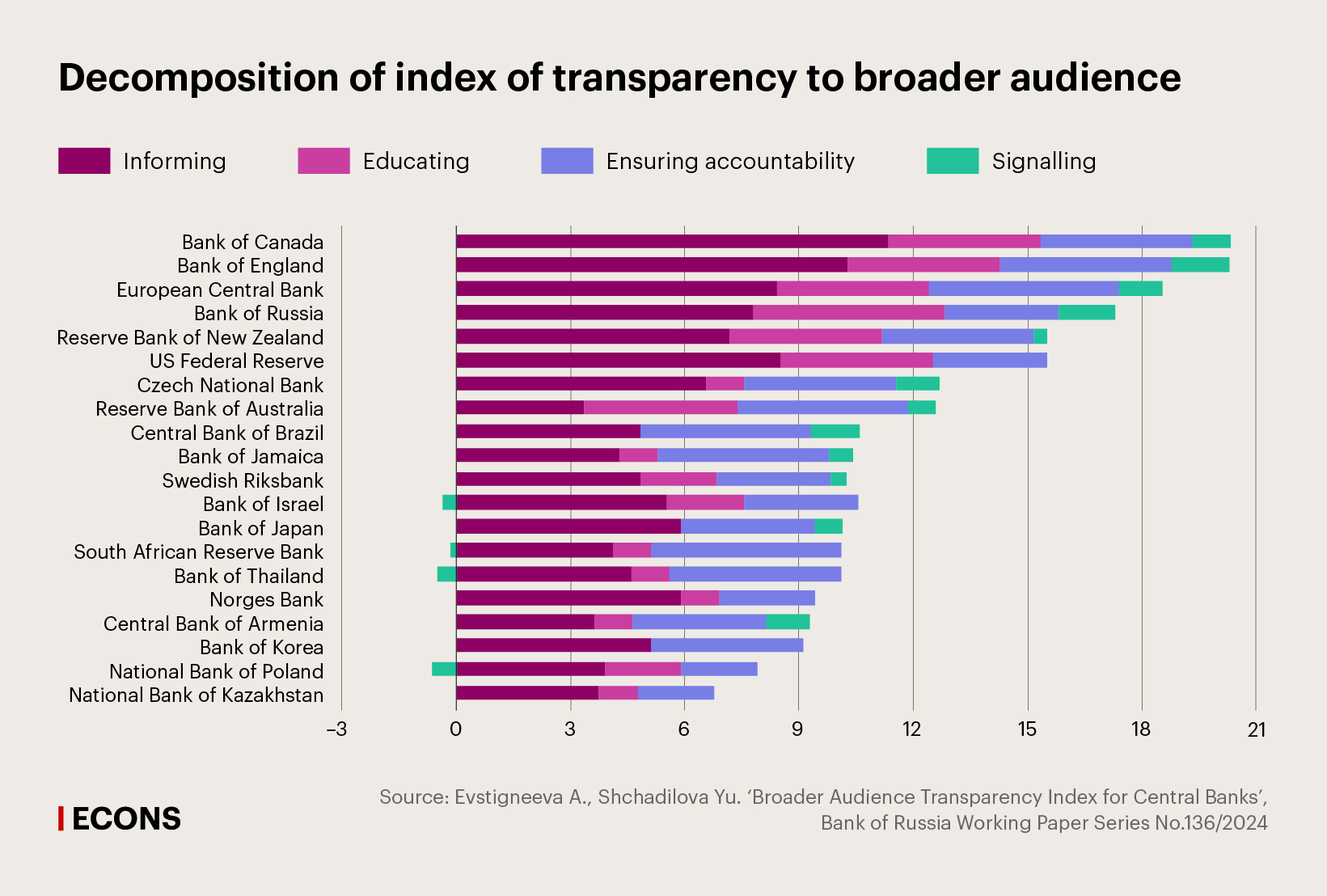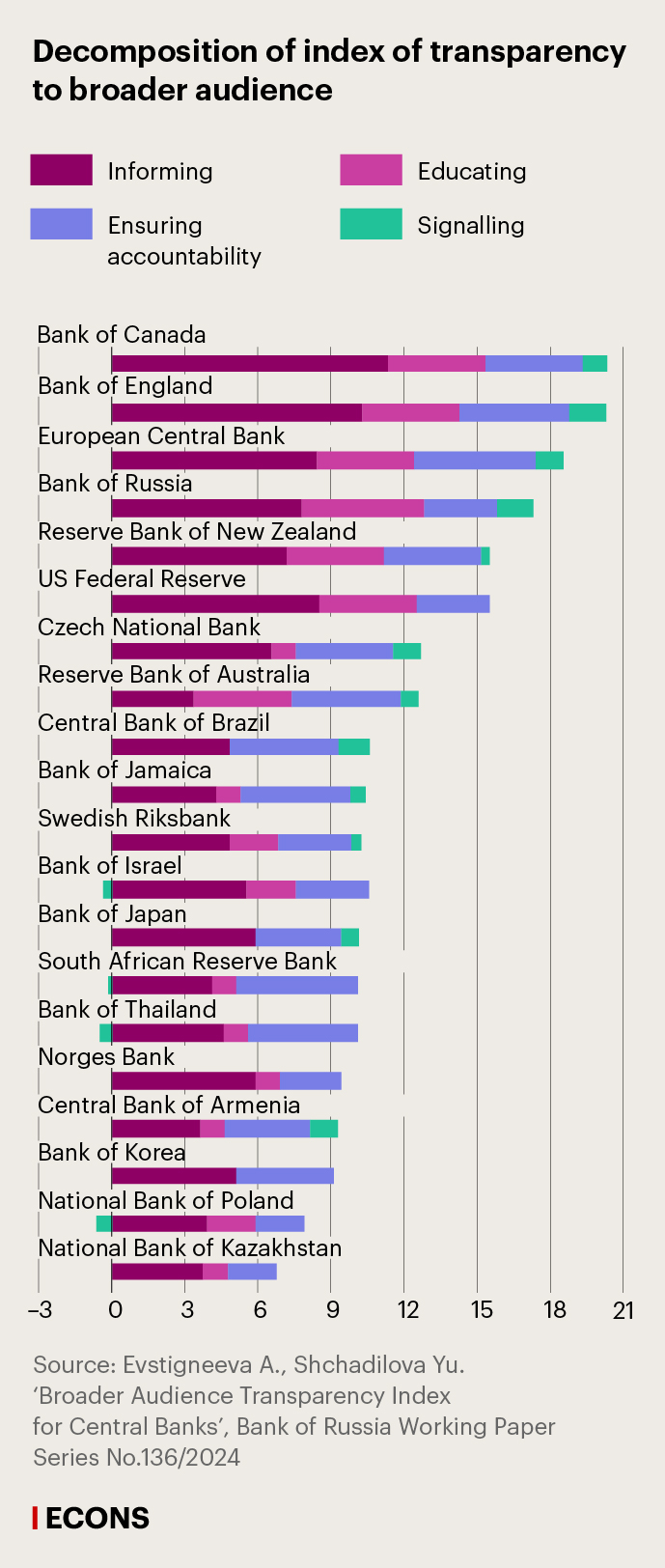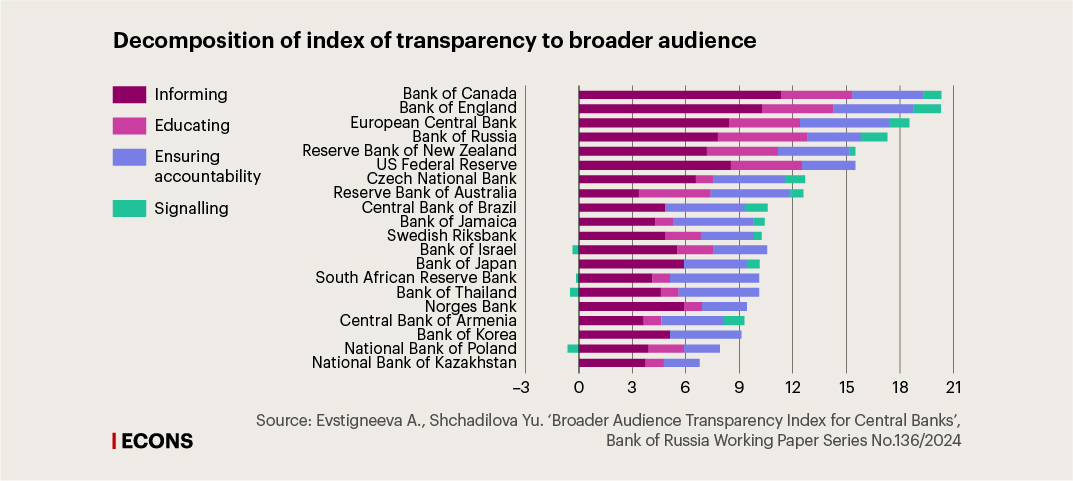Leg, Trunk or Ear: How to Assess Central Bank Transparency
Transparency is the first term to appear in any discussion about the quality of central bank communications, with the main conclusion to be drawn from such discussions being that modern central banks must be as transparent as possible. This may be called a general consensus, and the idea has become the fifth principle of Russian monetary policy.
Nonetheless, the question is what central bank transparency means. After a little research, it appears that ‘transparency’ is interpreted by central bankers, academic researchers, and the general public in three different ways, intersecting only in part. This is slightly reminiscent of the parable of the blind men and the elephant. The blind men, who have never come across an elephant before, learn and imagine what the elephant is like by touching it. The first, whose hand lands on the trunk, says, ‘This being is like a thick snake’. To the second, whose hand reaches its ear, it seems like a kind of fan. While the third, whose hand touches the leg, says the elephant is a pillar.
The Bank of Russia understands transparency as follows: ‘The Bank of Russia seeks to promptly and amply communicate the information on the goals, principles, measures and results of its monetary policy, as well as on the assessment of the economic situation and its prospects.' In other words, it tries to disclose information in a timely and complete manner.
In the academic literature, transparency is understood technically, i.e., how much useful information a regulator provides to analysts. In this context, a number of popular indices are used (1, 2, 3). They are based on an approach proposed by Italian economist Lorenzo Bini Smaghi and Director of the Institute for European Policymaking Daniel Gros in 2001. These indices have a fairly simple logic. Researchers make a checklist of the monetary policy materials central banks should publish and assess how many items from this list are covered by each bank. For instance, a central bank will receive one point for disclosing the code of its forecast models or alternative forecast scenarios and zero otherwise.
This family of indices is fully focused on the sufficiency of communication efforts as regards the professional community. However, the central banking environment has drastically changed in the last decades. A quiet revolution has taken place in communications, and there have been dramatic changes in media consumption: social media, podcasts, news aggregators, and vlogs have nearly replaced newspapers.
Awareness of the central banks' accountability to the public, the importance of financial literacy, the development of behavioural economics, and the more significant role of inflation targeting in turbulent times have forced central bankers to communicate in language that is understandable not only to economists but also to ordinary people. However, analyst-oriented indices say nothing about central bankers’ efforts in this area.
Transparency without Greek
Let us imagine a central bank that meets all 15 criteria of the index by Barry Eichengreen et al. or the 20 criteria of Al-Mashat’s index. The world has not yet seen such a central bank. If it had, this central bank would be regarded as incredibly transparent. It would publish a loss function evaluation, all macroeconomic statistics, and even the methodology of its forecast fan chart, to name just a few things. However, would this bank be transparent to people? The vast array of information published on its website would be perceived something like ‘Iliada’ in ancient Greek by non-experts, given the abundance of Greek letters in the models disclosed. Beautiful and formidable, but totally incomprehensible.
To evaluate central bankers’ efforts in communication with a broader audience, we have constructed a novel transparency index which is absolutely different from the indices focused on expert audiences. The full version of the article is available on the Bank of Russia website. Our index serves as a tool to determine the types of information intended for the general reader. The index criteria include the use of simple and clear language instead of model codes, the availability of easy-to-understand materials instead of output gap estimates, and clarity of signal instead of operational objectives.
The proposed Broader Audience Transparency Index (BATI) consists of four parts corresponding to the functions of public communication:
- informing
- educating
- ensuring accountability
- signalling
The index generally assesses how well central bank information is adapted for non-experts, how many channels central banks use to disseminate information, how actively they educate their audience, whether they communicate their values and mission, how they report on failures to achieve their targets, and how easy to understand their signals are, if any.
For example, our informing criteria include the presence of explanatory material for a broader audience – a short, easy-to-understand, visual version of a monetary policy document that a regulator publishes along with the version containing technical details designed for a professional audience. The Bank of England was the first to publish such a short version of its Inflation Report in 2017. As a result, activity on its website nearly doubled within 24 hours of the publication, as compared to previous reports. Moreover, a follow-up survey showed that 70% of respondents noted that this version of the report helped them better understand the content.
We factor in how often a regulator mentions households in its communications, assuming that the more people read about themselves (i.e., households), the more engaged they will be. We also take into account the proportion of personal pronouns from the 100 best English-language speeches of the 20th century, as the use of personal pronouns is essential for engaging audiences in addition to humour and emotive language. We consider how often central banks give interviews to non-business media, whether they make efforts to improve financial literacy to ensure better understanding of central banking (for example, whether they participate in educational programmes for schoolchildren and students), how consistent and clear their messages are, and if they communicate their ethical principles and the values shared by the public (link in Russian).
In total, the index has 40 criteria, of which three are punitive. For example, central banks may be downgraded due to redundant language, complicated syntax, and contradictory signals, which may impede dialogue with the public.
Our criteria are informed by previous research in various areas, including monetary policy, government information policy in a general sense, marketing, brand management, and cognitive psychology. The BATI is based on indicators whose value has been confirmed in empirical studies or thoroughly argued in theoretical academic papers. We also use natural language processing and large language model techniques to assess the criteria of the index. The assessment has the same logic as analyst-oriented indices, i.e., if a central bank meets a criterion, it receives the maximum of one point and zero otherwise (vice versa in the case of the punitive criteria).
Index and rating: results
The central banks earning the highest BATI scores are the Bank of Canada (20.33 out of 37), the Bank of England (20.28), and the European Central Bank (ECB) (18.53). These central banks make great efforts to improve their communication with the public. In particular, they have reworded their underlying texts into simple language and added infographics. In addition, the ECB has been actively using nearly all available channels to get its points across to ordinary people. The Bank of Canada has managed to focus its communication on non-experts with the aid of easy-to-understand messages, storytelling, direct address to people, and relevant topics.
The Bank of Russia is ranked fourth with 17.31 points. Its key strength has proved to be audience education (the policymaker uses all advanced practices in this field, e.g., it publishes an inflation calculator, has released Fincult.info (link in Russian), a special financial literacy resource, and has even launched the Econicum (link in Russian) mobile game application) and the development of information dissemination channels. The central bankers in Brazil, Jamaica and Thailand are worth noting, since they focus their communications on the establishment of a common platform of values shared by the public, i.e., they provide information about their socially important mission, values, charities, and the activities of ethics committees.



One of our not entirely expected conclusions was that the indices of transparency to broader and professional audiences are not correlated. When we started this work, we anticipated these indices to be high in advanced economies and low in emerging markets. In practice, we see several clusters of central banks on the communication vector. For instance, certain banks have been very successful in creating communications for analysts but have room for developing tools to communicate with the general public (e.g., the Czech National Bank or the National Bank of Poland), and vice versa: there are banks which release communications largely focused on a broader audience (e.g., the Bank of Canada).
Does high transparency always mean good?
If a central bank is highly transparent according to all criteria, then, to return to the parable about the blind men and the elephant, how is such transparency perceived by the public? A quite unambiguous answer to this question is given in a comment on our study posted in a Telegram channel: ‘It does not seem that the use of humour or a particular number of words in a press release can make a central bank really transparent. The point is that monetary policy is understandable to people and aligned with, rather than aloof from, reality.’ Here, transparency is thought to be alignment with expectations. This appears to be close to analysts' view on the issue of transparency. According to them, a transparent central bank is first and foremost a predictable central bank.
Our study evaluates technical transparency, i.e., the set of materials, whether they are comprehensible to people, and their dissemination network. Metaphorically speaking, this is the transparency and accessibility of the glass into which a central bank pours water. It is safe to say that the Bank of Russia boasts a cutting-edge set of public communication practices.
However, another question springs to mind: whether the essence of this communication (the ‘water’ in our metaphor) meets the needs and expectations of the public. To answer this question, researchers must resort to in-depth sociological tools. The study summarised here draws the conclusion that to improve its public communications, the Bank of Russia should focus on creating narratives rather than on developing its technical transparency further.
As for contradictory views on transparency, economists regressed the earliest transparency indices against key macroeconomic variables and financial market indicators to understand whether high central bank transparency was correlated with its efficiency. There has been no strong evidence for this so far. However, several studies have appeared casting doubts on the beneficial nature of communications. One of them caused great debate after the publication of the ‘It’s Not Always Good to Talk’ column in The Economist, stating that central bankers tended to be opinion leaders conveying their views on economic and market conditions. As a result, markets give too much weight to regulatory assessments and avoid forming views of their own. This can reinforce possible errors from which even in the best analysis is not immune.
Two decades after the column was published, it can be assumed that the authors’ concerns about the excessive public reaction to central bank communications have not been confirmed. Modern people exist in a rich information environment in which the voice of a central bank is unlikely to drown out signals from the private sector. Nowadays, central banks are more apprehensive about being unheard. That is why they use so many columns and videos, record reggae hits, and draw comics. Nevertheless, there is still a long way to go in advancing the public dialogue despite the progress made.







